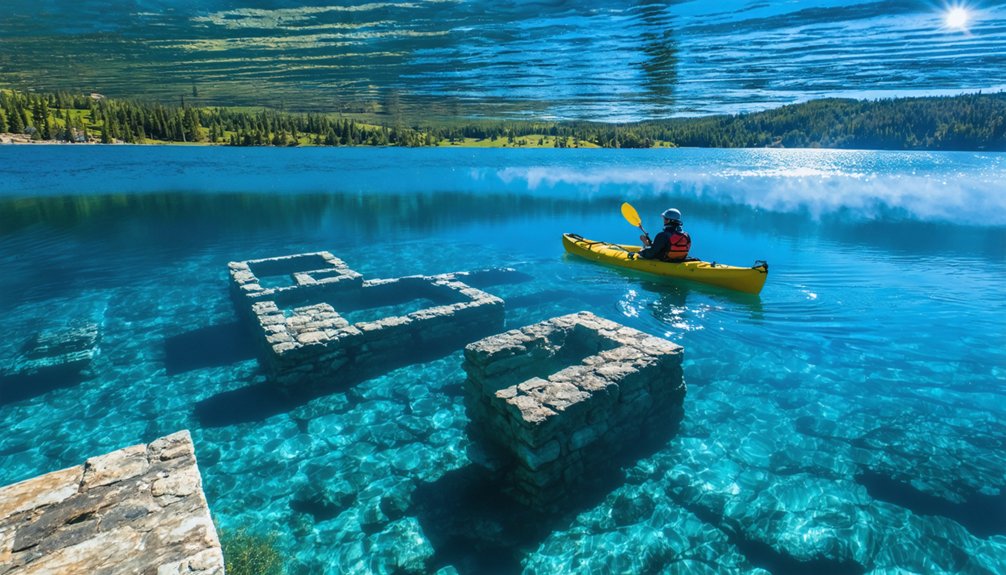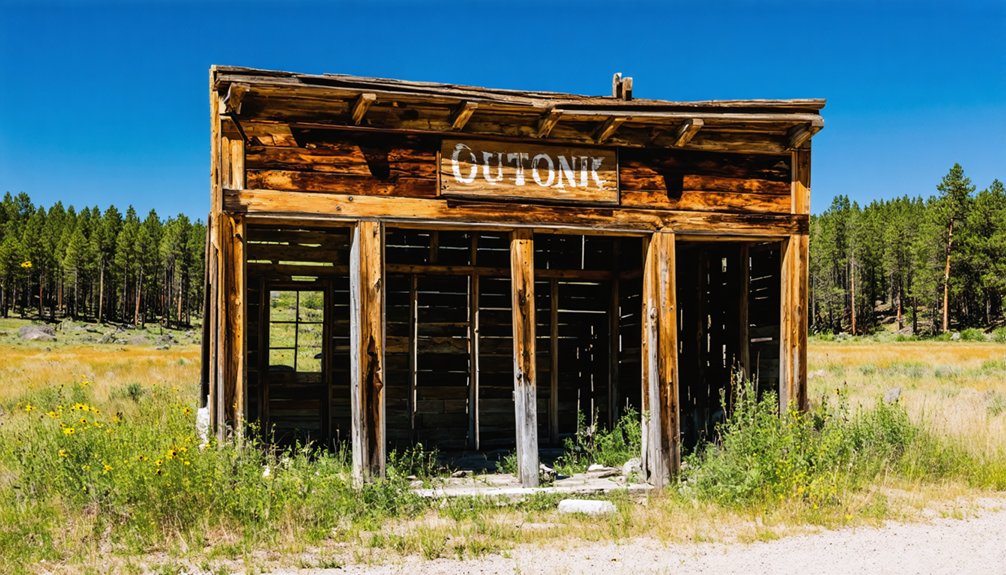When you visit Pactola Lake in South Dakota’s Black Hills today, you’re standing above what was once Camp Crook, a bustling mining town founded in 1883. Originally named Wickhamville, the settlement thrived during the Black Hills gold rush, reaching 300 residents by 1876. The town faced decline as gold deposits diminished, and in 1952, construction began on Pactola Dam. The waters that now draw thousands of recreational visitors each year hide a fascinating story beneath their surface.
Key Takeaways
- Pactola was originally Camp Crook, a thriving Black Hills mining town founded in 1883 that now lies underwater.
- The town became submerged when Pactola Dam was constructed in 1952, creating South Dakota’s largest reservoir.
- During the 1870s gold rush, Pactola reached 300 residents and housed the Black Hills’ first post office.
- The town declined as gold deposits diminished, leading to abandoned buildings and a dwindling population.
- Today, Pactola Lake serves as a recreational destination while preserving the submerged ghost town’s mining heritage.
The Birth of Camp Crook and Its Golden Dreams
Nestled along the Little Missouri River in South Dakota, Camp Crook began its journey in 1883 as the small settlement of Wickhamville, named after one of the area’s pioneering families.
Two years later, the town adopted its current name in honor of General George Crook, who’d led his troops through the region in 1876. You’ll find Camp Crook’s founding location strategically significant, as it’s the only town west of the Little Missouri River in South Dakota. The town would later host one of the region’s CCC conservation camps that operated for approximately two years.
Early settlers like Doc and Willie Latham drove cattle herds from Texas while working for prominent ranching operations in the 1880s. The settlement quickly established itself with notable structures that still stand today, including the historic St. Ann’s Catholic Church and the Little Missouri Bank Building, constructed in 1902.
From Camp Crook to Pactola: A Name Steeped in Legend
You’ll find it fascinating that Pactola’s name originated during a community meeting in Camp Crook, where an intoxicated lawyer drew inspiration from the golden-sanded Pactolus river of ancient Lydia.
The connection between this mythological river, where King Midas allegedly washed away his golden touch, resonated perfectly with the town’s dreams of striking it rich in the Black Hills Gold Rush.
The settlers embraced this classical parallel, officially transforming Camp Crook into Pactola to reflect their dreams of striking it rich in the Black Hills Gold Rush. Nearly three hundred miners worked the local placer mines during the town’s peak. Today, the original town lies under Pactola Lake, submerged during the dam’s construction in the 1950s.
Ancient Inspiration Behind Name
The naming of Pactola draws its roots from ancient mythology and the legendary river Pactolus in Lydia, modern-day Turkey. You’ll find that this wasn’t a random choice – the ancient legends tell of King Midas washing away his golden touch in the Pactolus, leaving its sands rich with gold.
This powerful gold symbolism resonated with the Black Hills miners who saw their own fortune-seeking reflected in these tales. Today, the town lies beneath Pactola Lake, a dramatic transformation from its mining origins. The area was first established in 1875 as Camp Crook before its legendary renaming.
During a community gathering, a lawyer’s spirited recitation of the Midas legend sparked the town’s transformation from Camp Crook to Pactola. The name captured the settlers’ aspirations, drawing a direct parallel between their gold-rich creek and the legendary river of antiquity.
This classical connection elevated their mining settlement beyond a mere camp, linking it to centuries of human prosperity and ambition.
Mining Town’s Golden Dreams
Miners flocked to Camp Crook in 1875 during the Black Hills gold rush, establishing one of the region’s earliest settlements along Rapid Creek.
Despite initial removal by authorities, their community resilience prevailed as they returned in 1876 when the territory officially opened. The settlement quickly grew to 300 residents, with mining techniques focused on placer deposits using sluices and flumes to extract gold from creek beds.
- Claims along Rapid Creek reached values of $50,000
- The town established the Black Hills’ first post office in 1877
- Sherman House hotel became a crucial stagecoach hub
- Mining operations expanded with railroad access
- Extensive flume systems supported placer mining operations
The promise of gold transformed Camp Crook into a bustling frontier town, though costly infrastructure and limited deposits would eventually challenge its prosperity. This area was particularly significant as sacred Lakota land that had been protected by Indigenous peoples for generations before mining began. The town’s legacy lives on beneath the waters of Pactola Reservoir, constructed in 1952 to provide water for the growing population of Rapid City.
Life in a Black Hills Mining Boomtown
During the bustling days of 1875-1876, life in Pactola centered around the daily rhythms of placer mining, as 300 prospectors worked the gold-rich sands of Rapid Creek. You’d find miners sluicing through creek beds, searching for precious gold flakes while maneuvering through the harsh realities of mining life in the untamed Black Hills.
The town quickly grew to meet miners’ needs, featuring supply stores, a post office, and a dance hall where you could unwind after a grueling day’s work. The discovery of high-grade silver ore by Jerry Hardy in 1877 sparked a new wave of excitement and prospecting activity in the area. The area’s mining history began with Lt. Col. Custer’s expedition in 1874, which first revealed the region’s mineral wealth.
Community challenges were ever-present – from the brutal physical demands of mining to the constant threat of violence, as evidenced by prospector Jerry Hardy’s murder in 1877.
Living conditions were basic, with miners occupying simple cabins and hastily built shacks near their claims. Community meetings helped establish order in this frontier boomtown.
The Decline of a Mining Community
The precious placer gold deposits around Pactola gradually diminished, forcing miners to abandon their sluicing operations and seek opportunities elsewhere.
You’d have seen businesses that once served the mining community start to close their doors as the economic foundation of the town crumbled.
The town’s population dwindled steadily as families moved away, leaving behind empty buildings and abandoned dreams of striking it rich in the Black Hills.
Mining Operations Fade Away
Despite initial success in placer gold mining along Rapid Creek, Pactola’s mining operations began facing significant challenges by the late 1870s.
What started as a promising mining settlement with 300 miners would eventually become another Black Hills ghost town. The decline of mining operations happened due to several factors:
- Limited placer gold deposits led to diminishing returns
- High costs of water delivery infrastructure strained resources
- Failed attempts to expand into other mineral operations
- Lack of sustained railroad access hindered transportation
- Expensive processing requirements exceeded profitable operations
As mining revenues dwindled, buildings were abandoned or relocated.
Economic Hardships Take Hold
As mining operations waned in Pactola, severe economic hardships gripped the once-thriving community, creating ripple effects that extended far beyond lost jobs.
You’d have witnessed the painful economic decline as the town’s infrastructure began to crumble, with fewer resources available to maintain essential services and roads. The shrinking population meant a diminished tax base, making it increasingly difficult to fund local schools and public works.
Without mining revenue flowing into local coffers, you’d have seen community challenges multiply. The town struggled to support basic services that residents had once taken for granted.
Former mining families moved away in search of new opportunities, leaving behind deteriorating buildings and reduced economic activity – a stark reminder of how quickly a community’s fortunes can change when its primary industry disappears.
Population Steadily Decreases
Once mining operations began faltering in Pactola, you’d have witnessed a steady exodus of residents that transformed the bustling town into a shell of its former self.
The harsh realities of dwindling economic opportunities triggered significant population migration, leaving behind deteriorating infrastructure and abandoned properties.
Key factors driving the town’s depopulation included:
- Closure of major mines eliminated primary employment sources
- Essential services and schools shut down as families relocated
- Limited job alternatives in the remote location prevented economic diversification
- Harsh winter conditions and rugged terrain discouraged new settlers
- Aging remaining residents couldn’t sustain population through natural growth
This downward spiral reflected broader regional trends, as rural mining communities throughout South Dakota experienced similar fates while urban areas grew.
Under the Waters: The Creation of Pactola Lake
When federal authorities approved the construction of Pactola Dam in 1952, they set in motion a project that would forever transform a historic Black Hills settlement into a sprawling reservoir.
The reservoir engineering project was massive, requiring over 4.3 million cubic yards of embankment fill and a workforce of 200 men who braved steep terrain and hard rock outcroppings.
You’ll find it fascinating that while no deaths occurred during construction, the project permanently altered the landscape, submerging the remnants of a once-bustling gold rush town beneath its waters.
Today, Pactola Lake serves as an essential water source for Rapid City, though it faces new ecological challenges, including the 2022 discovery of invasive zebra mussels.
The lake’s depths now hide the physical remains of early Black Hills history.
Legacy and Recreation at Modern-Day Pactola

Though the original town of Pactola lies beneath its waters, modern-day Pactola Lake has transformed into South Dakota’s largest reservoir and a vibrant recreational hub.
You’ll find a perfect blend of historical preservation and outdoor adventure, where community engagement and environmental stewardship shape the visitor experience.
- Fish for rainbow trout in crystal-clear waters
- Explore hiking trails in the surrounding Black Hills National Forest
- Visit interpretive markers highlighting the area’s mining heritage
- Join volunteer groups like Friends of Jenny Gulch for conservation efforts
- Enjoy water sports from kayaking to waterskiing during summer months
Local historical societies preserve Pactola’s mining legacy through documented stories and markers, while recreational activities draw thousands of visitors annually.
The lake’s management carefully balances flood control, ecosystem sustainability, and public enjoyment, ensuring future generations can experience this unique destination.
Frequently Asked Questions
What Was the Average Depth of Gold Mining Shafts in Pactola?
You’ll find gold extraction shafts averaged 500-1,000 feet deep, though mining techniques varied. Historic records aren’t definitive, but these depths aligned with typical Black Hills mining operations from the 1870s onward.
Were There Any Notable Crimes or Shootouts in Pactola’s History?
Surprisingly, you won’t find any documented shootouts or notable crimes in Pactola’s history. Despite the rough-and-tumble mining era, there’s no evidence of major mining disputes or outlaw encounters in historical records.
Did Any Famous Historical Figures Ever Visit the Mining Town?
You won’t find any famous visitors of historical significance in records from this mining town. Even General Crook, who expelled miners nearby in 1875, didn’t specifically visit the settlement.
What Happened to the Cemetery When the Town Was Flooded?
In 1877, the oldest marked grave was established. You’ll find they relocated the entire cemetery to Silver City’s hilltop before the flood impact, ensuring no graves were lost beneath Pactola Reservoir’s waters.
Are There Any Visible Remnants of the Town During Drought Conditions?
You’ll spot ghostly sightings of building foundations, old sluice boxes, and mine shafts when drought effects lower the reservoir’s water levels, though most structures were removed before flooding in the 1950s.
References
- https://www.silvercitysd.com/pactola
- https://www.sdpb.org/rural-life-and-history/2023-08-21/some-black-hills-ghost-towns-and-their-origins
- https://www.blackhillsbadlands.com/blog/post/old-west-legends-mines-ghost-towns-route-reimagined/
- https://www.onlyinyourstate.com/state-pride/south-dakota/pactola-underwater-ghost-town-sd
- https://kxrb.com/the-journey-to-south-dakotas-hidden-ghost-town/
- https://973kkrc.com/south-dakota-underwater-ghost-town/
- https://blackhillsvisitor.com/learn/pactola/
- https://973kkrc.com/south-dakota-underwater-ghost-town-2/
- https://npshistory.com/publications/usfs/region/1/early-days/3/sec5.htm
- https://npgallery.nps.gov/NRHP/GetAsset/NRHP/64000794_text



